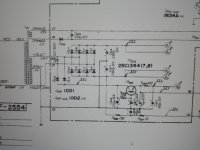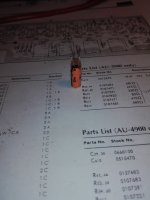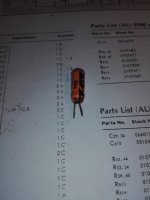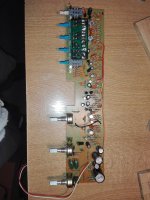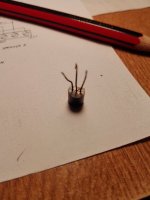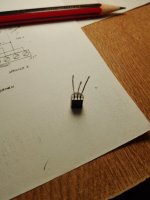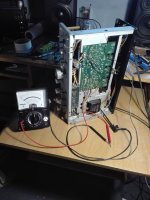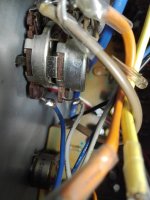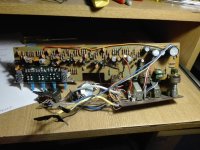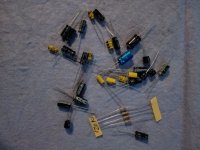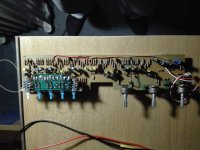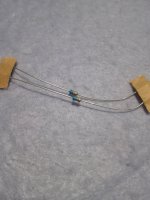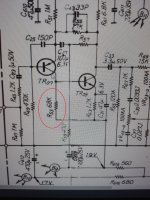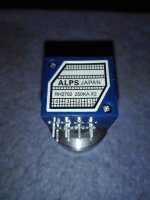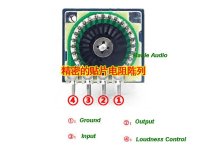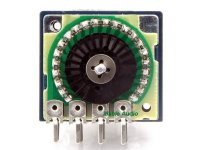Hi BSST
Thanks, I'll need it!
The random crackles and/or pops occur both with the potentiometer at O or maximum, currently it seems to be exclusive to the right channel and it is the one with the lowest volume when playing music.
Furthermore it seems that the replacement of the TRs pointed out as culprits on various websites has brought about a new problem, which I attribute to the fact that the TRs I got here are from HFE around 300, much more than the original 2SA726 and 2SC1313. What causes this? You can hear music even when the potentiometer is at zero ! ......strange, right ? The position of the internal cursor of the potentiometer diverts the signal to ground, completely canceling it, so there is some return that causes this phenomenon. Another issue is that in order to work on replacing the TR, as you can see in the photo, I had to disassemble everything and then the lack of ground in many metal parts (pot, int) is causing hums, for example when touching the shaft of volume.....
The position of the internal cursor of the potentiometer diverts the signal to ground, completely canceling it, so there is some return that causes this phenomenon. Another issue is that in order to work on replacing the TR, as you can see in the photo, I had to disassemble everything and then the lack of ground in many metal parts (pot, int) is causing hums, for example when touching the shaft of volume.....
So if I find the culprit item, I will reinstall the original TRs, because they are clearly not the TRs, neither the originals nor the replacements. I can confirm this because I started with the first TR at the input, and tested if the noise continued, so on until I reached the last one in the circuit. In the middle I went through volume control.... The random noise always appeared !
Thanks, I'll need it!
The random crackles and/or pops occur both with the potentiometer at O or maximum, currently it seems to be exclusive to the right channel and it is the one with the lowest volume when playing music.
Furthermore it seems that the replacement of the TRs pointed out as culprits on various websites has brought about a new problem, which I attribute to the fact that the TRs I got here are from HFE around 300, much more than the original 2SA726 and 2SC1313. What causes this? You can hear music even when the potentiometer is at zero ! ......strange, right ?
 The position of the internal cursor of the potentiometer diverts the signal to ground, completely canceling it, so there is some return that causes this phenomenon. Another issue is that in order to work on replacing the TR, as you can see in the photo, I had to disassemble everything and then the lack of ground in many metal parts (pot, int) is causing hums, for example when touching the shaft of volume.....
The position of the internal cursor of the potentiometer diverts the signal to ground, completely canceling it, so there is some return that causes this phenomenon. Another issue is that in order to work on replacing the TR, as you can see in the photo, I had to disassemble everything and then the lack of ground in many metal parts (pot, int) is causing hums, for example when touching the shaft of volume.....So if I find the culprit item, I will reinstall the original TRs, because they are clearly not the TRs, neither the originals nor the replacements. I can confirm this because I started with the first TR at the input, and tested if the noise continued, so on until I reached the last one in the circuit. In the middle I went through volume control.... The random noise always appeared !
Perhaps ground wire to volume pot is open or pot element itself. Check resistance from top of pot to circuit common. Also, ground pot shaft for possible hum reduction.
The volume potentiometer operates correctly, without noise or interruptions. Yes, I have put a cable from its metal body (axle) to the chassis. The phenomenon that music "plays" even at minimum volume appeared as I replaced the TRs. One channel becomes weaker after a very short time on, it starts well. All preamplifier solders were re-soldered. Everything remains the same.
As I interpret the schematic, the 2SA726 and 2SC1313 are used only in the preamp section--- right?
I don't believe the design should be susceptible to variation in Beta of the transistors. Do you notice any distortion in the sound as gain decreases in the problem channel? Do you have any feel for how much gain drops compared to the good channel? Try comparing bias voltages in the preamp stages with the good channel. Can you correlate a shift in bias bias voltage with the drop in gain? Do you have a scope or audio voltmeter?
I don't believe the design should be susceptible to variation in Beta of the transistors. Do you notice any distortion in the sound as gain decreases in the problem channel? Do you have any feel for how much gain drops compared to the good channel? Try comparing bias voltages in the preamp stages with the good channel. Can you correlate a shift in bias bias voltage with the drop in gain? Do you have a scope or audio voltmeter?
Hello BSST
Correct, only in the pre. 2SA726 was replaced by BC557 and 2SC1313 by BC547. I replaced the TRs one at a time and got the amp back up and running. I noticed that the volume increased somewhat with each step, I seem to remember that the sound began to "skip" the volume potentiometer only in the last two TR changes, both before the pot. of BAL and VOL. As I already mentioned, the volume difference was already there with the original TRs. To equalize the channels the balance was changed from 12 o'clock to the left to 10. But the "phenomenon" of not being able to override 0 arose later. I understand that the volume achieved at the pre output is determined by the circuit design with certain TR HFEs, it is a combination.
I don't have an oscilloscope, I do have two multimeters, one analog and the other digital.
Look at this comment from another forum, do you think these diodes can cause the clicking?
" .....Two of the main rectifier diodes on mine were shorted when I got it. Luckily the power transistors were intact. Sansui used 2 diodes in parallel on each leg of the bridge rectifier to meet the current requirement for a total of 8. This is OK if the diodes have the same drop but it isn't going to happen. One will draw more current than the other and will fail eventually.
Replace the 8 diodes with 4 of the proper current(2x the original) and peak inverse voltage(PIV) rating."
https://audiokarma.org/forums/index.php?threads/sansui-au-4900.77712/
Thank you for your time, much appreciated.
Correct, only in the pre. 2SA726 was replaced by BC557 and 2SC1313 by BC547. I replaced the TRs one at a time and got the amp back up and running. I noticed that the volume increased somewhat with each step, I seem to remember that the sound began to "skip" the volume potentiometer only in the last two TR changes, both before the pot. of BAL and VOL. As I already mentioned, the volume difference was already there with the original TRs. To equalize the channels the balance was changed from 12 o'clock to the left to 10. But the "phenomenon" of not being able to override 0 arose later. I understand that the volume achieved at the pre output is determined by the circuit design with certain TR HFEs, it is a combination.
I don't have an oscilloscope, I do have two multimeters, one analog and the other digital.
Look at this comment from another forum, do you think these diodes can cause the clicking?
" .....Two of the main rectifier diodes on mine were shorted when I got it. Luckily the power transistors were intact. Sansui used 2 diodes in parallel on each leg of the bridge rectifier to meet the current requirement for a total of 8. This is OK if the diodes have the same drop but it isn't going to happen. One will draw more current than the other and will fail eventually.
Replace the 8 diodes with 4 of the proper current(2x the original) and peak inverse voltage(PIV) rating."
https://audiokarma.org/forums/index.php?threads/sansui-au-4900.77712/
Thank you for your time, much appreciated.
Attachments
The latest news:
I have reviewed the soldering of the printed boards of the tone circuits and the key selector in the selector input.
Everything remains the same.
So I disconnected (I had already done this job before, I repeat it just to make sure that the fault does not appear after many hours of correct operation) the power supply and the L and R signal input of the preamplifier board, and I connected the Headphone audio output from a netbook that is no longer in use but that is useful for this task, (I don't want to disconnect my NAD3020 again which is connected to my main desktop computer) using a USB pen drive to play music.
I have left it working correctly for about 8 hours a day, I have turned it off and on again, both cold and hot, and everything is fine. The power plate works perfectly, both channels with the same volume. So all that remains is to remove the preamplifier board and carry out a thorough inspection, comparing the R and C values of the R and L channels. I hope to find the culprit of the random noise.
The PSU diodes are discarded, there is no specific power supply for the pre and another for the power. At least I think I interpret that from the circuit.
I have reviewed the soldering of the printed boards of the tone circuits and the key selector in the selector input.
Everything remains the same.
So I disconnected (I had already done this job before, I repeat it just to make sure that the fault does not appear after many hours of correct operation) the power supply and the L and R signal input of the preamplifier board, and I connected the Headphone audio output from a netbook that is no longer in use but that is useful for this task, (I don't want to disconnect my NAD3020 again which is connected to my main desktop computer) using a USB pen drive to play music.
I have left it working correctly for about 8 hours a day, I have turned it off and on again, both cold and hot, and everything is fine. The power plate works perfectly, both channels with the same volume. So all that remains is to remove the preamplifier board and carry out a thorough inspection, comparing the R and C values of the R and L channels. I hope to find the culprit of the random noise.
The PSU diodes are discarded, there is no specific power supply for the pre and another for the power. At least I think I interpret that from the circuit.
That's right, thank you, I had thought about that too.
I say:
" and the L and R signal input of the preamplifier board "
I stand corrected, it should say:
"and the sign L
and R output from preamp to power board"
I say:
" and the L and R signal input of the preamplifier board "
I stand corrected, it should say:
"and the sign L
and R output from preamp to power board"
And with luck I will find some resistor or some capacitor with values very far from those of the circuit......😉
Diodes, zeners, opamps, transistors, fets, they all can go bad in weird funny ways. But in most cases tapping on them or a splash with cold spray will show.
Thanks, but i see you haven't read the thread completely.
The preamplifier boards that I have left to review do not have diodes, zeners, or opamps. Only transistors, and I have already replaced them all, the failure persisting. It lies in some passive component of the noisy channel (the right one).
I tend to lean more towards some capacitor, but I don't rule out some resistance.
The preamplifier boards that I have left to review do not have diodes, zeners, or opamps. Only transistors, and I have already replaced them all, the failure persisting. It lies in some passive component of the noisy channel (the right one).
I tend to lean more towards some capacitor, but I don't rule out some resistance.
The latest news are:
I completely removed the preamplifier board.
I am examining all the electrolytic capacitors. This will take a while, so far the ones I've checked are fine. The intention is to find some defective, but I think it will still be better to replace ALL of them if I do not find any in obvious poor condition and/or out of value. If I can buy new ones of equal or very approximate values, something that will not be easy either.... Is 47 uF x 6.3 Volts a standard value today?
It catches my attention that a capacitor that looks like the photo measures well! (the respective mF values of each channel give similar values, they are not shorted and they charge and discharge correctly)
I have read that the black legs of the TR are rust, which is a silver bath that takes on that color when oxidized. It seems to me more like an original TR paint, because the supposed rust is very even, what do you think? You can also see in the other photo that there is dirt between the conductive legs, it was similar to a paste that perhaps acted as a conductor between EBC. Again, many doubts and few certainties in this regard.
So I proceeded to clean the legs of ALL the original pre TRs, since the new ones did not solve the crackles, and they have an HFE that was too high (min.300) compared to the originals (min.50) which brought other inconveniences. .
Any comments are welcome, as always.
I completely removed the preamplifier board.
I am examining all the electrolytic capacitors. This will take a while, so far the ones I've checked are fine. The intention is to find some defective, but I think it will still be better to replace ALL of them if I do not find any in obvious poor condition and/or out of value. If I can buy new ones of equal or very approximate values, something that will not be easy either.... Is 47 uF x 6.3 Volts a standard value today?
It catches my attention that a capacitor that looks like the photo measures well! (the respective mF values of each channel give similar values, they are not shorted and they charge and discharge correctly)
I have read that the black legs of the TR are rust, which is a silver bath that takes on that color when oxidized. It seems to me more like an original TR paint, because the supposed rust is very even, what do you think? You can also see in the other photo that there is dirt between the conductive legs, it was similar to a paste that perhaps acted as a conductor between EBC. Again, many doubts and few certainties in this regard.
So I proceeded to clean the legs of ALL the original pre TRs, since the new ones did not solve the crackles, and they have an HFE that was too high (min.300) compared to the originals (min.50) which brought other inconveniences. .
Any comments are welcome, as always.
Attachments
Well, I replaced all the electrolytic capacitors in the preamp and put the original TRs back in.If your volume control is wonky, this would be the time to replace it.
You won't be sorry.
I also changed a bias resistor that had the wrong value (47 KOhms instead of 68 KOhms that appears in the circuit). I don't now if it was some modification of Sansuí, I was reviewing notes from my youth to calculate it correctly but I haven't been able to determine it by calculations, too complicated...so I thought that a little more resistance won't hurt.
The amplifier works "almost" perfect, 0 Volts DC at the output is good!
But, the problem persists of the volume difference between the two channels and that there is sound even with the volume control at minimum. So I tried putting the cursor to (-) chassis and it cuts perfectly. Absolute zero, that's the culprit.
Tell me Rayma, are you a witch, a fortune teller or something like that !? 👍😊 I really thought that a potentiometer that slides perfectly, that is not noisy, and that was cleaned with aerosol cleaning liquid was an indication that it was OK, but I see that is not the case. Now comes the difficult part, repair it or buy a new one? I'm leaning towards the latter, I haven't found out locally yet, but I found something on the internet, it looks like an imitation of ALPS, made in China, what do you think?
https://tiendamia.com/ar/producto?amz=B09VYB1YLC&pName=MiZOELEC Potentiometer 250K Log Alps Audio Amp Volume Control Pot Stereo W Loudness Potentiometers
Attachments
Last edited:
The previous plate in post 35 and here the restored one. The size of capacitors and resistors has been miniaturized to the point that one is suspicious that "that blue" could be 470 Microfarads.....🙄
Attachments
Finally the potentiometer arrived. I've never had one of these in my hands, so I was surprised by the build quality. And the reward I got for waiting is that it is a step potentiometer, something that was not listed in the seller's description.
I have also been lucky because it seems that this 250 KOhms model is no longer manufactured. It is strange, although it does not appear on the official ALPS site, - which would confirm that - on the other hand, in a thread right here (now closed) someone states that this value was never manufactured by ALPS. And therefore it is an imitation.
Well, anyway, the construction is excellent and now I have to see how I can manage to connect it, since the connection of the pins is different from that of the original potentiometer. I hope the length of the amplifier cables is enough. Any ideas and/or comments from those who have already done this work will be greatly appreciated.
https://www.diyaudio.com/community/threads/alps-rh2702.345112/
I have also been lucky because it seems that this 250 KOhms model is no longer manufactured. It is strange, although it does not appear on the official ALPS site, - which would confirm that - on the other hand, in a thread right here (now closed) someone states that this value was never manufactured by ALPS. And therefore it is an imitation.
Well, anyway, the construction is excellent and now I have to see how I can manage to connect it, since the connection of the pins is different from that of the original potentiometer. I hope the length of the amplifier cables is enough. Any ideas and/or comments from those who have already done this work will be greatly appreciated.
https://www.diyaudio.com/community/threads/alps-rh2702.345112/
Attachments
Last edited:
- Home
- Amplifiers
- Solid State
- Resistance with random crackles in Sansui AU4900, is it possible?
